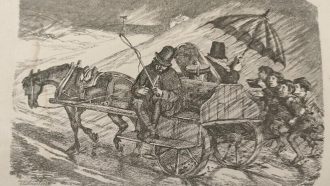What 19th century travel guides had to say about Ireland
ToggleTravel reviews and reports from that period provide insights into Irish society, culture and 'people drinking whiskey, porter and punch', writes Catherine Ahearne, Special Collections and Archives. MU library

Travel guides from the late 1700s into the 19th century held in the Russell Library were primary by male, British, well-off and non-Catholic writers. Their opinions were coloured by prevailing narratives at the time, and evolving national identities, where being Irish was intrinsically linked with being Catholic, rebellious, particularly in the aftermath of the 1798 rebellion and morally and socially inferior.
In his book "Travels in Ireland, in the year 1822, exhibiting brief sketches of the moral, physical, and political state of the country: with reflection on the best means of improving its condition", Thomas Reid cannot fathom why the Irish live in this poverty despite the being under the wing of the Great British government, as the following extract demonstrates:

Also evident in his, and other texts, are sterotypes still at play today. In Reids' case, he discusses his perception that fighting is a part of Irish nature:
"….fighting is a pastime, which they seldom assemble without enjoying; …. with light clubs, which they always carry, and frequently and skilfully use…. they willingly consume whole days in sloth, or as willingly employ them in riot".
Another writer from this time, Rev. James Hall, A.M. describes the drunken scenes at the threatre during his trip to Dublin in 1813:
"The players are obsequious to the galleries, and seem more desirous of pleasing these deities, than the less numerous visitors of the pit and boxes. How genteel people in the city put up with this, I know not; for it is notorious that rioting prevails in the galleries; people drinking whiskey, porter, punch &c. &c. there, and getting drunk, as if they were in an ale-house".
Despite this he also calls out the sophiciated nature of Dublin noting that "I could not help sometimes fancying myself in London".
While the testimonies above feed into prevailing social views of the time, there were other writers who offered a different view, especially those who travelled with the purpose of showing the Irish in a more positive light and highlight the contradictions with the descriptions of Irish people as commonly appearing in newspapers of the time. For example writing about his tour in 1805, Sir John Carr’s acknowledges that:
"the principal murders and depredations which are stated to have been committed in Ireland from some time past, have been manufactured by the editors of English Newspapers, to fill up a vacancy in their prints. Upon these occasions, Limerick and its neighbourhood are generally selected for the scene of blood and outrage……This selection is rather an unfortunate one as Limerick, since the year 1798, has been particularly free from any spirt hostile to the repose of society."
During this tour, Carr took the time to examine the character of lower classes of Irish people. This examination is a mixed report depending on which county you hail from!
"The lower Irish are remarkable for their ingenuity and docility and a quick conception ; in these properties they are equalled only by the Russians"…."The handsomest peasants in Ireland are the natives of Kilkenny and the neighbourhood……In the county of Roscommon the male and female peasantry and horses are handsome….In the county of Kerry, along the Western shores, the peasants very much resemble the Spaniards in the expression of countenance, and colour of hair."
Written by Baptist Wriothesley Noel,"Notes of a short tour through the midland counties of Ireland, in the summer of 1836, with observations on the condition of the peasantry" viewed Ireland as a strange anomaly. While it was united with Great Britain, he saw the population as a weakness rather than strength to the British cause and religious reformation:
"its eight millions are our weakness rather than our strength….Notwithstanding the influence of a large Protestant establishment, it remains, 300 years after the Reformation, more Papal than the north of Italy".
Notwithstanding this, he states his reasons for coming to Ireland clearning - to examine for himself what the truth was of the Irish and their situation:
"I wished, therefore, to see for myself the real condition of the people ; whether they are miserable or not, whether they are advancing to civilization and plenty, to order, religion, and happiness, or doomed to still deeper degradation; what may be learned from their virtues, or what can be done to mitigate their sorrows.
Concluding quite positively that:
"On many accounts Ireland deserves to be visited and known……...its peasantry are often said, not withstanding their privations, to be the finest in the world; and for intellect, vivacity, and warmth of affection, perhaps they are unequalled".
We may have moved from tour books such as this to an age of influencers, but visitors will share their experiences and opinions of the country and its food, music, scenery and, most importantly, people. When future generations look back over the hospitality of the Ireland of the 21st century, will our "warmth of affection" still be evident or will we have left evidence behind of a different type of Ireland?
We can only hope that those who examine our character in the future will also examine the character of the writer to see and explore why they will have chosen to write about the Irish in a particular tone. Only time will tell what the future opinion will be of the Irish character, but I hope that it will be a positive one.
This article originally appeared on RTE Brainstorm.
